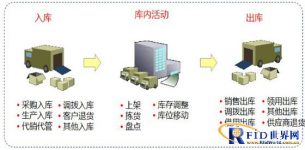
Jiukun Intelligent Warehouse Management System
[ad_1]
Jiukun Intelligent Warehouse Management System (J-WMS) is a warehouse management system developed by Shenzhen Jiukun Information Technology Co., Ltd. for electronic appliances, machinery manufacturing and other industries.
The system aims to solve the difficult problems of warehousing and logistics management of production and processing enterprises, the process is not clear, the data statistics are not timely, and the responsibility tracking is not clear.By barcode orRFIDThe technical real-time data collection system can realize real-time statistics of warehouse outbound, inbound, inventory, and shifting data, avoiding errors and low efficiency during traditional manual operations. These dynamic real-time data are an important foundation for the implementation of MES systems and ERP systems, helping companies realize informatization and automated management, thereby improving corporate efficiency and reducing corporate costs.
1 Overview:
◇Realize automatic data collection through barcode and RFID technology;
◇Realize mobile operations with the help of mobile terminals and improve work efficiency;
◇Seamless integration with common ERP systems such as SAP, Yonyou U8, U9, NC, Kingdee K3, Oracle EBS, etc.;
◇Scientific, practical, simple and convenient operation to ensure data integrity and security;
◇Cover all activities of common warehouse management.

2. System function overview:

Storage: Including purchase receipt, outsourcing receipt, production receipt, R&D return, customer return, etc.
Outbound: Including outsourcing delivery, production delivery, outbound delivery, R&D picking, supplier return, etc.
Move the library: support one-step library transfer and two-step library transfer (first move out, then move in) two kinds of library transfer
Inventory: Including generating inventory list, inventory entry, automatic generation of difference report, inventory profit and loss processing
Material put on the shelf: Collect material put on the shelf information in real time through the handheld terminal, and save the record
Material off-shelf: Collect material off-shelf information in real time through a handheld terminal, and save the records
Quick inventory: quickly inventory the materials on the shelf through the handheld terminal
Inventory query: search and query inventory information based on material number, position, inventory type, etc.
Inbound and outbound records query: query inbound and outbound records by time, business type, material number, warehouse, etc.
Integrate with ERP system: query purchase orders, production orders, outbound delivery orders and other information from related systems in real time, and report the warehousing records to the ERP system
Basic data maintenance: including the maintenance of basic material data, warehouse basic data, electronic label information, supplier information, freight forwarder information, and customer information
Barcode printing: automatically print barcode labels, save the association between cargo information and electronic labels;
electronic labelCard Issuing: Issue RFID electronic tags to save the association between cargo information and electronic tags;
Voucher printing: supports printing of various warehousing and outbound business vouchers;
System management: including user information, role information, authority management, system parameter settings, etc.
3. System network structure diagram

4. System Architecture
The system is based on the .NET platform, and the main business of the warehouse is designed with the B/S architecture; the mobile terminal software adopts the C/S architecture and interacts with the application server through the WebService interface.
The entire software architecture is divided into three architecture levels, namely the client layer, the server layer and the data layer.

5. Implement benefit analysis
Explicit cost improvement
Explicit cost improvement includes an increase in inventory turnover rate, a decrease in the number of products in progress, a decrease in the amount of idle inventory, a decrease in the bulk material rate, and the paperless operation of business process documents.
Implicit cost improvement
Implicit cost improvement includes the improvement of the stability and accuracy of production planning and material planning, the improvement of product quality, and the improvement of supply chain reaction time.
Paperless homework
WMS system through the introduction of advanced hardware solutions such as wireless information technology, PDA, bar code, RFID, etc., enables on-site data collection to be more timely and efficient, and the B/S and C/S system architecture allows system information to be borrowed anytime and anywhere. Communication technology and barcode carrier realize paperless business process control and operation. Thereby eliminating paper-based input and transmission errors, improving the efficiency of business processes, and reducing costs.
Supply chain improvement
The implementation of the WMS system provides the most timely, accurate and reliable decision-making information for supply chain management and production operation management through process data collection and control such as receiving materials, material preparation and station material management. Through the improvement of these information flows and business processes, the response speed of the supply chain has been greatly improved, and a firm foundation has been laid for the realization of the company’s overall goals.
[ad_2]


